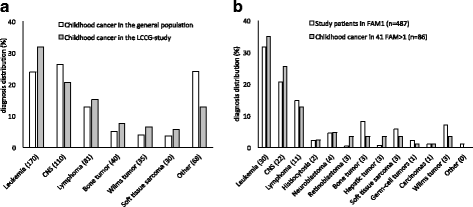Predominance of girls with cancer in families with multiple childhood cancer cases
- PMID: 29258538
- PMCID: PMC5738226
- DOI: 10.1186/s12885-017-3899-8
Predominance of girls with cancer in families with multiple childhood cancer cases
Abstract
Background: Recent studies indicate that one of four childhood cancers can be attributed to hereditary genetic abnormalities.
Methods: The Lund Childhood Cancer Genetic study includes newly diagnosed childhood cancer patients as well as childhood cancer survivors visiting the Department of Pediatrics or the Late Effect Clinic at Skåne University Hospital, Lund, Sweden. Questionnaires regarding family history of cancer and blood samples were provided. Reported data were validated and extended by use of the Swedish Population- and Cancer Registries. Demographics in families with one case of childhood cancer (FAM1) were investigated and compared to families with multiple cases of childhood cancer (FAM > 1) as well as to childhood cancer in the general population.
Results: Forty-one out of 528 families (7.8%) had more than one case of childhood cancer. In 23 families the affected children were relatives up to a 3rd degree (4.4%). In FAM > 1, 69.2% of the children with leukemia and 60% of those with tumors in the central nervous system (CNS) had a childhood relative with matching diagnosis, both significantly higher than expected. Significantly more female than male patients were observed in FAM > 1 compared to FAM1. This female predominance was most striking in childhood leukemia (77% female) and also, yet to a lesser extent, in CNS tumors (68% female).
Conclusions: We conclude that the high proportion of children with leukemia or CNS tumors in FAM > 1 having a childhood relative with the same diagnosis suggests a hereditary background. Moreover, we report a female predominance in childhood leukemia and childhood CNS tumors in FAM > 1, which may indicate a hereditary gender-specific risk factor in these families.
Keywords: Familial cancer predisposition; Genetic cancer susceptibility; Hereditary cancer syndrome; Pediatric cancer.
Conflict of interest statement
Ethics approval and consent to participate
The study was approved by the Regional Ethics Review Board, Lund University, Sweden (no. 2008/233, 2010/231 and 2011/33). Access to the Population Registry and Cancer Registry was approved for participants and relatives.
Consent for publication
Written informed consent for publication has been acquired from all 534 study patients and/or legal guardian.
Competing interests
The authors declare no conflict of interest. The funders of the study had no role in the study design, data collection, data analysis, data interpretation, or writing of the report. The corresponding author had full access to all the data in the study and had final responsibility for the decision to submit it for publication.
Publisher’s Note
Springer Nature remains neutral with regard to jurisdictional claims in published maps and institutional affiliations.
Figures

Similar articles
-
Childhood central nervous system tumors and leukemia: Incidence and familial risk. A comparative population-based study in Utah and Norway.Pediatr Blood Cancer. 2020 Aug;67(8):e28408. doi: 10.1002/pbc.28408. Epub 2020 May 21. Pediatr Blood Cancer. 2020. PMID: 32437093 Free PMC article. Clinical Trial.
-
Italian cancer figures--Report 2015: The burden of rare cancers in Italy.Epidemiol Prev. 2016 Jan-Feb;40(1 Suppl 2):1-120. doi: 10.19191/EP16.1S2.P001.035. Epidemiol Prev. 2016. PMID: 26951748
-
Italian cancer figures, report 2012: Cancer in children and adolescents.Epidemiol Prev. 2013 Jan-Feb;37(1 Suppl 1):1-225. Epidemiol Prev. 2013. PMID: 23585445 English, Italian.
-
Pediatric Central Nervous System Tumors in Nepal: Retrospective Analysis and Literature Review of Low- and Middle-Income Countries.World Neurosurg. 2015 Dec;84(6):1832-7. doi: 10.1016/j.wneu.2015.07.074. Epub 2015 Aug 14. World Neurosurg. 2015. PMID: 26283488 Review.
-
Space-time clustering of childhood cancers: a systematic review and pooled analysis.Eur J Epidemiol. 2019 Jan;34(1):9-21. doi: 10.1007/s10654-018-0456-y. Epub 2018 Nov 16. Eur J Epidemiol. 2019. PMID: 30446850 Free PMC article.
Cited by
-
Differential and Common Signatures of miRNA Expression and Methylation in Childhood Central Nervous System Malignancies: An Experimental and Computational Approach.Cancers (Basel). 2021 Oct 31;13(21):5491. doi: 10.3390/cancers13215491. Cancers (Basel). 2021. PMID: 34771655 Free PMC article.
-
Prevalence of germline pathogenic variants in 22 cancer susceptibility genes in Swedish pediatric cancer patients.Sci Rep. 2021 Mar 5;11(1):5307. doi: 10.1038/s41598-021-84502-4. Sci Rep. 2021. PMID: 33674644 Free PMC article.
-
Trends in Childhood Cancer in Kuwait: Data From the 2004-2017 Registry.Cureus. 2021 Feb 13;13(2):e13333. doi: 10.7759/cureus.13333. Cureus. 2021. PMID: 33643753 Free PMC article.
References
-
- Friedman DL, Kadan-Lottick NS, Whitton J, Mertens AC, Yasui Y, Liu Y, Meadows AT, Robison LL, Strong LC. Increased risk of cancer among siblings of long-term childhood cancer survivors: a report from the childhood cancer survivor study. Cancer Epidemiol Biomark Prev. 2005;14(8):1922–1927. doi: 10.1158/1055-9965.EPI-05-0066. - DOI - PubMed
-
- Curtin K, Smith KR, Fraser A, Pimentel R, Kohlmann W, Schiffman JD. Familial risk of childhood cancer and tumors in the li-Fraumeni spectrum in the Utah population database: implications for genetic evaluation in pediatric practice. International journal of cancer Journal international du cancer. 2013;133(10):2444–2453. doi: 10.1002/ijc.28266. - DOI - PMC - PubMed
-
- Neale RE, Stiller CA, Bunch KJ, Milne E, Mineau GP, Murphy MF. Familial aggregation of childhood and adult cancer in the Utah genealogy. International journal of cancer Journal international du cancer. 2013;133(12):2953–2960. - PubMed
-
- Pang D, McNally R, Kelsey A, Birch JM. Cancer incidence and mortality among the parents of a population-based series of 2604 children with cancer. Cancer Epidemiol Biomark Prev. 2003;12(6):538–544. - PubMed
MeSH terms
LinkOut - more resources
Full Text Sources
Other Literature Sources
Medical

